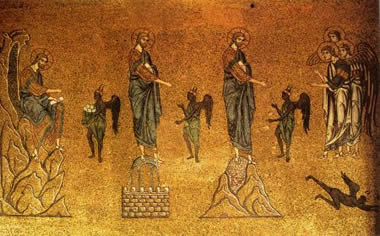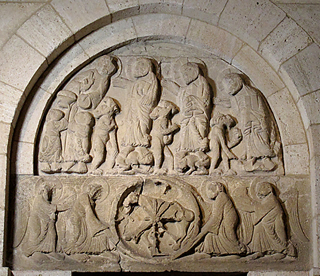"I Know How You Feel"
The Baptism and Temptation of Jesus
For Sunday January 8, 2012
Lectionary Readings (Revised Common Lectionary, Year B)
Genesis 1:1–5
Psalm 29
Acts 19:1–7
Mark 1:4–11
In The Last Temptation of Christ (1988), a film based upon the novel by Nikos Kazantzakis, director Martin Scorsese portrays a very human Jesus. He confesses his sins, he fears insanity, he wonders if he's merely a man, and he anguishes over the people he didn't heal.
In his "last" or ultimate temptation, during his execution Jesus battles a hallucination sent by satan. He wonders what his life might have been like if he had chosen the path of an ordinary person. He imagines marrying Mary Magdalene, growing old, and having kids. But then his disciples reproach him for abandoning his special mission, and through their reproach he returns to consciousness to accomplish his final suffering, death, and resurrection.
 |
Temptation in the Desert, 15th-century France. |
Many Christians were outraged by Scorsese's film and considered it blasphemous. Blockbuster Video even refused to carry it. What bothered many Christians was the suggestion that Jesus was fully and truly human, that he was a person who experienced trials and temptations, faults and failures, just like we do — torment, doubt, loneliness, questions, fantasies, confusion, despair, erotic dreams, and, in his final hours, feeling abandoned by God.
This impulse to air brush the humanity of Jesus has a long history. The second-century gnostics and docetics (from the Greek dokeo, "to seem or appear") argued that Jesus only "seemed" human. Surely he couldn't have been polluted by our material existence! In trying to "protect" Jesus from a genuine human nature, though, we do the exact opposite of what he himself does in his baptism and temptation. Instead of insulating himself from us, he fully participates with us.
Similarly, a hundred years after the event, Jesus's baptism made some Christians nervous. In the non-canonical Gospel of the Hebrews (c. 80–150 AD), Jesus seems to get baptized to please his mother, not to repent for his sins like everyone else: "The mother of the Lord and his brothers said to him, 'John the Baptist baptizes for the forgiveness of sins; let us go and be baptized by him.' But he said to them, 'In what way have I sinned that I should go and be baptized by him? Unless, perhaps, what I have just said is a sin of ignorance.'”
But the reading from Mark this week is insistent. Jesus was baptized in the Jordan River, and then tempted or tried in the desert: “At once the Spirit sent him into the desert, and he was in the desert forty days, being tempted by Satan. He was with the wild animals, and angels attended him” (Mark 1:12–13, NIV). The Spirit of God descended upon Jesus in baptism, and then the Spirit of God cast him into the desert to be tempted and tried.
 |
Temptations of Christ, 12th-century mosaic, St. Marl's Basilica, Venice. |
With his baptism, Jesus inaugurated his public ministry by identifying with "the whole Judean countryside and all the people of Jerusalem." He took upon himself the faults and failures, the pains and problems, of all the broken people who had flocked to the Jordan River. By wading into the waters with them he took his place beside us and among us. Not long into his public mission, the sanctimonious religious leaders derided Jesus as a "friend of gluttons and sinners." They were right about that.
His temptation by satan emphasizes this point. The parallel passages in Matthew and Luke specify three temptations: turning stones to bread, throwing himself down from the temple, and accepting the glories of earthly kingdoms. Interpreters have variously categorized these three temptations. I like Henri Nouwen's suggestion that they represent our perennial temptations to be relevant, spectacular and powerful (see In the Name of Jesus).
Interpreting the three temptations just so doesn't matter, for we know these were not Jesus’s only temptations. In Luke's version, at the end of the forty day trial satan left Jesus only “until an opportune time” (Luke 4:13). He came back again and again those next three years. Like us, there was never a time in his life when he didn't experience trial and temptations. His ultimate temptation, and the ultimate despair anyone can experience, was the sense of feeling forsaken by God in Gethsemane.
Jesus was tempted not only in the desert but throughout his entire earthly life: "For we do not have a high priest who is unable to sympathize with our weaknesses, but we have one who has been tempted in every way, just as we are—yet was without sin. Let us then approach the throne of grace with confidence, so that we may receive mercy and find grace to help in our time of need” (Hebrews 4:15-16, NIV)
 |
Temptation of Christ:, 12th-century Tympanum, Church of Errondo, Spain. |
The God who loves us empathizes with all the ambiguities, complexities, trials and temptations of our lives. In our weaknesses, our feelings of being forsaken and forgotten, our temptations to despair, Jesus says, "I know how you feel. Take comfort and confidence in God's grace, and never give in to shame or self-hatred."
Having been baptized and tempted, Jesus is the friend of sinners, not their enemy. One of the more remarkable characterizations of Jesus in the gospels is that he was “a friend of tax collectors and sinners” (Luke 7:34). We read that social and moral outcasts flocked around Jesus, much to the chagrin of the religiously righteous. They clearly felt safe with Jesus, accepted, embraced, and welcomed by him.
Based upon this gospel text, the Presbyterian pastor J. Wilbur Chapman (1859-1910) wrote the well known hymn, Jesus, What a Friend for Sinners! (1910). The second verse is my favorite:
Jesus! What a strength in weakness!
Let me hide myself in him.
Tempted, tried, and sometimes failing,
He, my strength, my victory wins.
As the friend of sinners who suffered trials and temptations, “he is able to help those who are being tempted” (Hebrews 2:18). He is for us, not against us.
In the fall of 2003 I spent two weeks in Oxford doing some writing, and one Sunday attended Saint Aldates Church. No one knows for certain who Saint Aldates was, but their first rector, Reginald, started serving the church in 1226. As I walked through the church doors, the usher enthusiastically greeted me, “We welcome all sinners!" Those were words I needed to hear. They capture the meaning of Jesus's baptism and temptation: ”I have not come to call the righteous, but sinners” (Mark 2:15-17). Indeed, “this man welcomes sinners and eats with them.” (Luke 15:2).
Image credits: (1) ACatholicWomansPlace.blogspot.com; (2) BlessedIsTruth's Blog; and (3) The Metropolitan Museum of Art.





